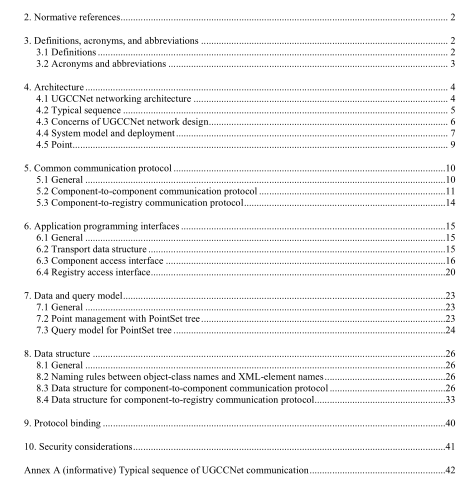IEEE 1888-2014 pdf download.IEEE Standard for Ubiquitous Green Community Control Network Protocol
NOTE—This specification extends the traditional concept of Point in facility networking. Traditionally, “point” originally stood for a specific device to enable direct access (by read and write method). This definition is still true when the target component is a gateway. However, in this specification, Storage and APPs have the same interface as GWs, so we extended the definition not only to access them but also to manage the data sequences related to them.
In writing a value to a Point, if the component has a GW implementation, the associated physical actuator would work according to the written value. If the component has a Storage implementation, the value would be archived in its disk.
4.5.3 URI-based identification A Point is associated to a globally unique data sequence. The data shall have been generated from a specific sensor or to a specific actuator in the world. Thus, in order to identify the data sequence globally, each Point should have a globally unique identifier. Note that for private operation, it does not necessarily need to be globally unique. However, it is not recommended. In UGCCNet, every Point shall have a URI for its identifier.
Practically, we will first assign IDs for physical sensors and actuators, and then we will use the IDs for the Point IDs. This operation goes well with the traditional facility networking operation. Taking URI for identifiers enables global access (if the Point is public) to the Point. Let X(=http://gw.foo.org/sensor1) be a Point ID.
If components do not know the registry server that manages the Point ID (X), they should try to access X directly. Then, the URI can redirect to the registry server. If components already know the registry server for X, Point ID may not need to be reachable. However, in order to obtain operational consistency, the host of the URI should be the host name of the GW (because physical sensors and actuators are attached to the GW). Thus, typical URI format should be: point ID = “http: //<GW host name>/<any format to identify the Point in the GW>”
4.5.4 PointSet This specification also defines PointSet to enable hierarchical management of Points. A PointSet aggregates multiple Points and multiple PointSets. This definition allows the conventional operation of grouping of Points hierarchically. However, the PointSet feature is optional. All the components should allow operation without PointSet. See 8.3.2.5 for formal definition.
5. Common communication protocol
5.1 General This specification defines two types of communication protocols for components and registry, including the component-to-component communication protocol and component-to-registry communication protocol. The protocol message for component-to-component and component-to-registry communication is intended to use Simple Object Access Protocol (SOAP) (see W3C, SOAP Version 1.2 Part 1: Messaging Framework).
5.2 Component-to-component communication protocol
5.2.1 Types of component-to-component communication protocol This subclause specifies and describes the following three types of sub-protocols for component-to- component communication. Note that instances of components are GWs, Storages, and APPs. As for the accessing methods to a registry, see 5.3.
FETCH protocol—for data retrieval from a remote component.
WRITE protocol—for data transfer to a remote component.
TRAP protocol—for event query registration and event data transfer.
The latter part of this subclause describes these protocols in detail. 5.2.2 FETCH protocol FETCH is a protocol for data retrieval from a remote component. We denote here the component that inquires data from the remote component by Requester, and the component that replies with the data by Provider. Figure 6 provides a diagram of the interaction.
Phase 1: The Requester invokes the query method of its Provider. The Requester shall send query information (i.e., the range of interested dataset), and should send the size of acceptable dataset at the RPC- response by the number of value element, at the same time. If the acceptable size is not specified, the server should use 100 for it as the default setting.IEEE 1888 pdf download.IEEE 1888-2014 pdf download
IEEE 1888-2014 pdf download

Leave a Reply